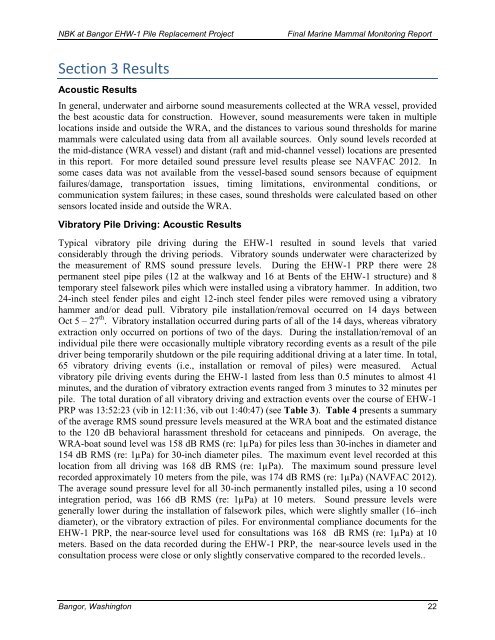Section 1 Introduction - National Marine Fisheries Service - NOAA
Section 1 Introduction - National Marine Fisheries Service - NOAA
Section 1 Introduction - National Marine Fisheries Service - NOAA
You also want an ePaper? Increase the reach of your titles
YUMPU automatically turns print PDFs into web optimized ePapers that Google loves.
NBK at Bangor EHW-1 Pile Replacement Project Final <strong>Marine</strong> Mammal Monitoring Report<br />
<strong>Section</strong> 3 Results<br />
Acoustic Results<br />
In general, underwater and airborne sound measurements collected at the WRA vessel, provided<br />
the best acoustic data for construction. However, sound measurements were taken in multiple<br />
locations inside and outside the WRA, and the distances to various sound thresholds for marine<br />
mammals were calculated using data from all available sources. Only sound levels recorded at<br />
the mid-distance (WRA vessel) and distant (raft and mid-channel vessel) locations are presented<br />
in this report. For more detailed sound pressure level results please see NAVFAC 2012. In<br />
some cases data was not available from the vessel-based sound sensors because of equipment<br />
failures/damage, transportation issues, timing limitations, environmental conditions, or<br />
communication system failures; in these cases, sound thresholds were calculated based on other<br />
sensors located inside and outside the WRA.<br />
Vibratory Pile Driving: Acoustic Results<br />
Typical vibratory pile driving during the EHW-1 resulted in sound levels that varied<br />
considerably through the driving periods. Vibratory sounds underwater were characterized by<br />
the measurement of RMS sound pressure levels. During the EHW-1 PRP there were 28<br />
permanent steel pipe piles (12 at the walkway and 16 at Bents of the EHW-1 structure) and 8<br />
temporary steel falsework piles which were installed using a vibratory hammer. In addition, two<br />
24-inch steel fender piles and eight 12-inch steel fender piles were removed using a vibratory<br />
hammer and/or dead pull. Vibratory pile installation/removal occurred on 14 days between<br />
Oct 5 – 27 th . Vibratory installation occurred during parts of all of the 14 days, whereas vibratory<br />
extraction only occurred on portions of two of the days. During the installation/removal of an<br />
individual pile there were occasionally multiple vibratory recording events as a result of the pile<br />
driver being temporarily shutdown or the pile requiring additional driving at a later time. In total,<br />
65 vibratory driving events (i.e., installation or removal of piles) were measured. Actual<br />
vibratory pile driving events during the EHW-1 lasted from less than 0.5 minutes to almost 41<br />
minutes, and the duration of vibratory extraction events ranged from 3 minutes to 32 minutes per<br />
pile. The total duration of all vibratory driving and extraction events over the course of EHW-1<br />
PRP was 13:52:23 (vib in 12:11:36, vib out 1:40:47) (see Table 3). Table 4 presents a summary<br />
of the average RMS sound pressure levels measured at the WRA boat and the estimated distance<br />
to the 120 dB behavioral harassment threshold for cetaceans and pinnipeds. On average, the<br />
WRA-boat sound level was 158 dB RMS (re: 1µPa) for piles less than 30-inches in diameter and<br />
154 dB RMS (re: 1µPa) for 30-inch diameter piles. The maximum event level recorded at this<br />
location from all driving was 168 dB RMS (re: 1µPa). The maximum sound pressure level<br />
recorded approximately 10 meters from the pile, was 174 dB RMS (re: 1µPa) (NAVFAC 2012).<br />
The average sound pressure level for all 30-inch permanently installed piles, using a 10 second<br />
integration period, was 166 dB RMS (re: 1µPa) at 10 meters. Sound pressure levels were<br />
generally lower during the installation of falsework piles, which were slightly smaller (16–inch<br />
diameter), or the vibratory extraction of piles. For environmental compliance documents for the<br />
EHW-1 PRP, the near-source level used for consultations was 168 dB RMS (re: 1µPa) at 10<br />
meters. Based on the data recorded during the EHW-1 PRP, the near-source levels used in the<br />
consultation process were close or only slightly conservative compared to the recorded levels..<br />
Bangor, Washington 22
















